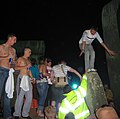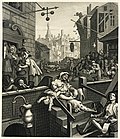Binge drinking

Editor-In-Chief: Prab R Tumpati, MD
Obesity, Sleep & Internal medicine
Founder, WikiMD Wellnesspedia &
W8MD medical weight loss NYC and sleep center NYC
| Binge drinking | |
|---|---|

| |
| Synonyms | N/A |
| Pronounce | N/A |
| Specialty | N/A |
| Symptoms | Intoxication, hangover, blackouts, alcohol poisoning |
| Complications | Alcohol use disorder, liver disease, cardiovascular disease, neurological damage, injuries, violence |
| Onset | Typically begins in adolescence or early adulthood |
| Duration | Episodes last several hours |
| Types | N/A |
| Causes | Excessive alcohol consumption |
| Risks | Peer pressure, social norms, mental health disorders, genetic predisposition |
| Diagnosis | Based on drinking patterns and blood alcohol concentration |
| Differential diagnosis | Alcohol use disorder, alcohol dependence |
| Prevention | Education, policy interventions, behavioral interventions |
| Treatment | Counseling, support groups, medication |
| Medication | N/A |
| Prognosis | Varies; risk of developing alcohol use disorder |
| Frequency | Common among young adults and college students |
| Deaths | N/A |
Binge drinking is a pattern of alcohol consumption that brings the blood alcohol concentration (BAC) level to 0.08% or more. This pattern of drinking is typically observed in adults over the age of 21 and is often associated with a range of negative health and social consequences.
Definition[edit]
The National Institute on Alcohol Abuse and Alcoholism (NIAAA) defines binge drinking as a pattern of drinking alcohol that brings the blood alcohol concentration (BAC) to 0.08% or above. For a typical adult, this pattern corresponds to consuming five or more drinks (male), or four or more drinks (female), in about two hours.
Health Risks[edit]
Binge drinking poses significant health risks, including the development of alcohol use disorder, liver disease, cardiovascular disease, stroke, and cancer. It can also lead to poor decision making, risky behavior, and accidents or injuries.
Social and Economic Impact[edit]
The social and economic impacts of binge drinking are substantial. These include lost productivity, healthcare costs, crime, and other social problems. Binge drinking can also lead to domestic violence, child neglect and abuse, and absenteeism in the workplace.
Prevention and Treatment[edit]
Prevention and treatment of binge drinking involve a combination of public health interventions, policy changes, and individual counseling. These may include alcohol education programs, cognitive behavioral therapy, and medication.
Gallery[edit]
-
Binge drinking
-
Binge drinking
-
Binge drinking
-
Binge drinking
-
Binge drinking
-
Binge drinking
See Also[edit]
Ad. Transform your life with W8MD's Budget GLP-1 injections from $75


W8MD offers a medical weight loss program to lose weight in Philadelphia. Our physician-supervised medical weight loss provides:
- Weight loss injections in NYC (generic and brand names):
- Zepbound / Mounjaro, Wegovy / Ozempic, Saxenda
- Most insurances accepted or discounted self-pay rates. We will obtain insurance prior authorizations if needed.
- Generic GLP1 weight loss injections from $75 for the starting dose.
- Also offer prescription weight loss medications including Phentermine, Qsymia, Diethylpropion, Contrave etc.
NYC weight loss doctor appointmentsNYC weight loss doctor appointments
Start your NYC weight loss journey today at our NYC medical weight loss and Philadelphia medical weight loss clinics.
- Call 718-946-5500 to lose weight in NYC or for medical weight loss in Philadelphia 215-676-2334.
- Tags:NYC medical weight loss, Philadelphia lose weight Zepbound NYC, Budget GLP1 weight loss injections, Wegovy Philadelphia, Wegovy NYC, Philadelphia medical weight loss, Brookly weight loss and Wegovy NYC
|
WikiMD's Wellness Encyclopedia |
| Let Food Be Thy Medicine Medicine Thy Food - Hippocrates |
Medical Disclaimer: WikiMD is not a substitute for professional medical advice. The information on WikiMD is provided as an information resource only, may be incorrect, outdated or misleading, and is not to be used or relied on for any diagnostic or treatment purposes. Please consult your health care provider before making any healthcare decisions or for guidance about a specific medical condition. WikiMD expressly disclaims responsibility, and shall have no liability, for any damages, loss, injury, or liability whatsoever suffered as a result of your reliance on the information contained in this site. By visiting this site you agree to the foregoing terms and conditions, which may from time to time be changed or supplemented by WikiMD. If you do not agree to the foregoing terms and conditions, you should not enter or use this site. See full disclaimer.
Credits:Most images are courtesy of Wikimedia commons, and templates, categories Wikipedia, licensed under CC BY SA or similar.
Translate this page: - East Asian
中文,
日本,
한국어,
South Asian
हिन्दी,
தமிழ்,
తెలుగు,
Urdu,
ಕನ್ನಡ,
Southeast Asian
Indonesian,
Vietnamese,
Thai,
မြန်မာဘာသာ,
বাংলা
European
español,
Deutsch,
français,
Greek,
português do Brasil,
polski,
română,
русский,
Nederlands,
norsk,
svenska,
suomi,
Italian
Middle Eastern & African
عربى,
Turkish,
Persian,
Hebrew,
Afrikaans,
isiZulu,
Kiswahili,
Other
Bulgarian,
Hungarian,
Czech,
Swedish,
മലയാളം,
मराठी,
ਪੰਜਾਬੀ,
ગુજરાતી,
Portuguese,
Ukrainian






